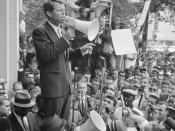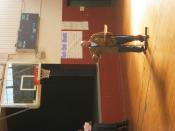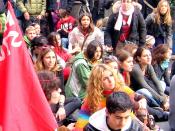Comparing "Blue Winds Dancing" with "Lunch Counter sit-ins"
The reason for choosing the "lunch Counter Sit-ins" in comparison with the short
story "Blue Winds Dancing", is because they both deal with inequalities and acceptance
between different races, especially between minorities and Caucasians. Both the "Lunch
Counter Sit-ins", and the short story "Blue Winds Dancing" take place in the early
1970's. In addition to have taken place around the same time, both take place in a time
when negativity towards minorities was not looked down upon. From segregation in
transportation, education, and public facilities, to having returned in exile to one's
village, they both represent a time unforgotten.
The story "Blue winds dancing" is a short story about a man named Tom
Whitecloud, who has to deal with his problems towards society. Tom Whitecloud was a Native American who grew up with his family on a reservation.
When he became old enough, he left home and went to national universities. Even throughout college he deals with his feelings of inadequacy everyday. Instead of trying to coincide with this "white society", as he refers to it as, tom decides he would be better off almost giving up and returning in exile to his village of origin, which is exactly what he does.
The Lunch Counter sit-ins mainly deal with non-violent direct action for the blacks to be served at the same lunch counters as those of the white people. The first sit-in had very little effect until the civil rights organizations began to spread the word to other college campuses. Gordon Carey, a representative from the Congress of Racial Equality (CORE), came down from New York to organize more sit-ins. Ella Baker of the SCLC contacted students on many college campuses. Two weeks later, students in...


